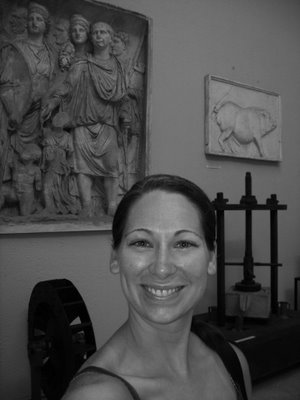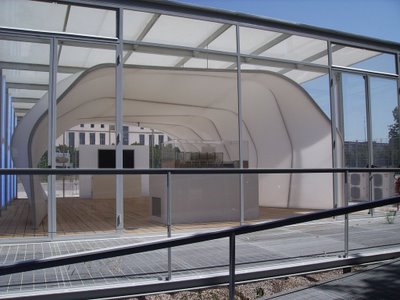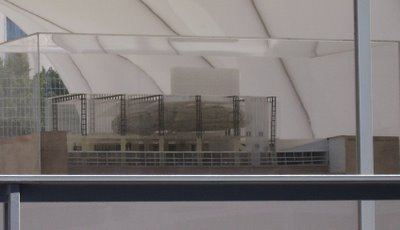117 EUR 1
From Sunday.
I'm south of the city and in the strange land of EUR, Mussolini's great urban design experiment: Esposizione Universale di Roma. Aside from a handful of buildings and monuments that are well-done, most of it is just as ugly and deserted as many U.S. cities on a Sunday.
The main reason I travelled to EUR was to see the the Museo della Civilta Romana (Roman Civilization), and it probably would have been really incredible if it was the 1st thing I saw here: full of ancient Roman inscriptions, artifacts, and art. But honestly, after 9 weeks, I'm a little saturated with this kind of stuff.

(above: Suz, saturated. I am mastering the art of self-photography.)
The two best parts of the museum were:
1. Plaster casts from Trajan's Column: 125 total panels that measure approximately 4' high by 9' long (below). It kind of feels like: here's the story of my civilization, in a nutshell, with heroes and commoners, animals, buildings, food, battles, religion, technology, engineering, how people fought, how they built, how they harvested. It makes you wonder how we would depict our current civilization graphically, without language.

The disappointing part was the lack of women in the depictions - 1% is probably a generous estimate. Although - the largest single figure portrayed is a woman, possibly a representation of Athena, although she is winged.
2. And the best part of the museum.... drumroll... is the 1:250 scale model of ancient Rome. This monster is approximately 40' x 40' in plan and shows all of Rome at its height in the 4th century (below).

In the background, by the way, is another plaster cast - this one from the Arch of Constantine.
I looked at this model for about an hour, and I could have easily stayed longer. It was so fascinating to see the recreation and compare it to what is left today. I also made a movie, which I would be happy to email to you if you're interested. Below is the center of ancient Rome, looking north-west. Start at the Colosseum. Palatine Hill is just to the left. And just to the right and a little higher of the Palatino is the Roman Forum with the basilica-plan temples. The larger complex to the right of the Colosseum is the bath of Trajan. And of course, the inner city wall is prevalent in the model. I took lots of photos, so when I have some time I'll be updating many old posts with applicable photos from the model.






